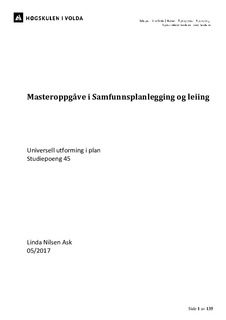| dc.description.abstract | Universell utforming er et ungt fagområde som det ikke er forsket mye på og temaet er i stadig utvikling. I denne masteroppgaven undersøkes det hvordan universell utforming er fulgt opp i planperioden 2011-2015 og hva dette betyr for legitimiteten til fagområdet. Virkemidlene i plan- og bygningsloven skal brukes slik at bebyggelse og områder har løsninger som i størst mulig grad skal være uavhengig av den enkeltes funksjonsevne. Ved å benytte virkemidlene i plan- og bygningsloven vil en få en god forankring av universell utforming. Fylkeskommunene er valgt med bakgrunn i at de har ulik forankring av universell utforming i sine overordnede planer og i sine delplaner. Det er valgt en kommune i hvert fylke for å kunne se hvordan overføringen er mellom de tre forvaltningsnivåene stat, fylkeskommune og kommune. Hovedfokuset i oppgaven er imidlertid på hvordan fylkeskommunene jobber med universell utforming. Denne forskningen er todelt hvor første fase var å undersøke utvalgte plandokumenter for å finne ut hvordan universell utforming er forankret i disse. Dette danner grunnlaget for neste fase som er basert på intervju med informanter i de tre fylkeskommunene om hvordan det jobbes med universell utforming. De utvalgte casene er Møre og Romsdal fylkeskommune, Molde kommune, Hordaland fylkeskommune, Stord kommune, Rogaland fylkeskommune og Stavanger kommune. Resultatene analyseres og drøftes i lys av planleggings- og legitimitetsteori samt forståelse av universell utforming på et makro, meso og mikronivå. I denne masteroppgaven påpekes et behov for en sterkere statlig føring i arbeidet med universell utforming, og at det utvikles en strategi samt Rikspolitiske retningslinjer for universell utforming slik at det gis konkrete virkemidler og tiltak for å oppnå det universelt utformede samfunnet. Det påpekes at det bør bli en tydeligere rollefordeling mellom den regionale stat (Fylkesmannen) og Fylkeskommunen, og det bør utvikles sjekklister til hjelp i planleggings-prosessene og til uttalelser i plansaker. Standardene som er utarbeidet for universell utforming bør brukes i anskaffelsesprosesser for å unngå at mangel på kunnskap fører til dårligere resultater. Det understrekes at mobilisering ift planprosesser og brukermedvirkning i enkeltprosjekter bør styrkes for å komme fram til en felles forståelse om hva som må gjøres for å nå målsettinger om universell utforming i de forskjellige sektorene. Dette vil styrke den kommunikative tilnærmingen til fagfeltet som er viktig for å få til en god balanse mellom den ekspertdrevne og instrumentelle top-down og den kommunikative bottom-up tilnærmingen. | nb_NO |
| dc.description.abstract | Summary
Universal design is a fledgling discipline of which there has been undertaken little research, and which is constantly evolving. This master thesis examines how universal design was implemented during the 2011-2015 planning period and what this means for the legitimacy of the discipline. Tools in the Planning and Building Act shall be deployed so that buildings and areas are accessible, as far as possible, independently of an individual's functional capacity. The use of tools in the Planning and Building Act, will ensure that universal design is well integrated. The county councils are chosen because they have integrated universal design into their plans in different ways. One municipality from each county has been selected to see how policy is transferred between the three administrative levels of state, county and municipality. The primary focus of the thesis, however, is on how the county councils work with universal design. The research focus is twofold whereby the first phase investigates planning documents (plans) to find out how universal design policy is integrated into the main plans. This then formed the basis for the second phase which is based on interviews with the three councils about their work with universal design. The selected cases are from Møre og Romsdal county council, Molde municipal council, Hordaland county council, Stord municipal council, Rogaland county council and Stavanger municipal council. The results have then been analysed and discussed with respect to both planning theory and legitimacy theory as well as with an understanding of universal design at macro, meso and micro levels. The research concludes that there is a need for stronger guidance from the state level with respect to implementing universal design. A national strategy for universal design, as well as planning guidelines, should be developed to provide specific tools and measures to realise a universally designed (accessible) society going forward. There should be a clearer division of roles between the regional state (county governor) and county council, and checklists should be developed to aid in the planning process and to assist public authorities with their evaluation and statements in connection with consultation processes. The use of universal design standards, which describe how universal design can be achieved, should be encouraged in public procurement to avoid a lack of knowledge leading to poorer results. Finally, it is emphasised that mobilisation during the planning process and user involvement in individual projects should be strengthened so as to reach a common understanding of what needs be done to achieve universal design goals within different sectors. This will strengthen the communicative approach to the discipline which important for securing a good balance between the expert driven instrumental top-down and communicative bottom-up approaches. | nb_NO |
